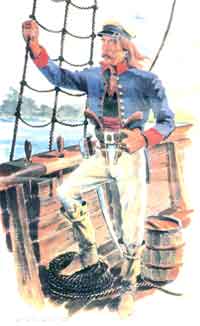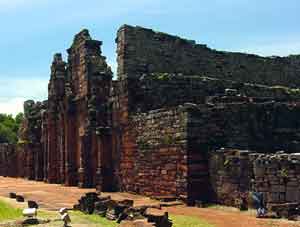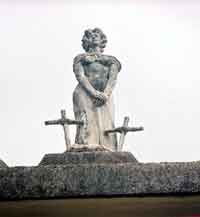|
Uruguay
Known as
Banda Oriental until the 1900s,
Uruguay
was a part of the Spanish colonial Viceroyalty of the River
Plate. In 1814, José Artigas and other leaders broke with the
governing junta in
Buenos Aires,
initiating a struggle for independence which lasted until
Brazil’s annexation of Uruguay in 1821. The Eastern Republic
of Uruguay was constituted in 1830.
In 1762 the
Irish-born captain John McNamara led a British force to occupy
Colonia del Sacramento, a stronghold alternately held by the
Portuguese and the Spanish. The expedition ended in failure
and McNamara lost his life in the attempt, together with most
of his men. Brigadier-General Samuel Auchmuty occupied
Montevideo
in 1807 with a regular force of British and Irish officers and
rank and file. British rule in Uruguay lasted fourteen months,
a period during which prominent merchants from Britain and
Ireland settled in the city, influencing its culture. One
Irish soldier enlisted in the 71st Regiment, Peter
Campbell (1780-c1832), remained in the River Plate and served
in the patriot ranks. He fought under Artigas and was
appointed deputy governor of Corrientes province. Campbell is
credited as a founder of the Uruguayan navy.
|

Montevideo
(E. Essex Vidal, 1820) |
Often
perceived by the English and Irish press as part of the same
country as Buenos Aires and Paraguay, Uruguay started to
receive a steady flow of Irish immigration in the decades
subsequent to independence. The countryside, especially in Rio
Negro district, was settled by sheep-farmers from Kilrane
parish in County Wexford. Paysandú, in the same district and
close to the Argentine
province
of Entre Ríos, was settled by immigrants from Westmeath and
Longford.
In the 1840s,
following Juan Manuel de Rosas' dictatorship in Buenos Aires,
which was favourable to British settlement, many Irish
sheep-farmers moved from Uruguay to Buenos Aires province and
leased or purchased land in counties such as Carmen de Areco,
Salto, and Pergamino, and later Nueve de Julio and Lincoln.
Landowners such as James Gaynor (1802-1892) and John Maguire
(d. 1905) moved to Argentina but maintained their properties
in Uruguay and when they died left important estancias on the
eastern bank of the River Plate. Other Irish settlers worked
in Entre Ríos in
Argentina
and Rio Negro in Uruguay. William Lawlor (1822-1909) of
Abbeyleix,
County
Laois,
married in Gualeguay, Entre Ríos and died in his ranch "Las
Tres Patas" in Uruguay. It is likely that other Irish ranchers
owned land on both sides of the Argentine-Uruguayan border,
speculating on the prospects of political and financial
stability in each country. However, simultaneous management
on both sides of the River Plate did not initiate migration
chains from Ireland to Uruguay as it did in Argentina.

Peter Campbell (1780-c1832)
(by F. Reilly, 1973) |
Two
distinguished Irish physicians in
Uruguay were Constantine Conyngham (1807-1868), who rendered
important services during the epidemic of 1856 in
Montevideo,
and Dublin-born Louis Fleury, surgeon-general to the army in
Charity Hospital. Among the rural settlers were J. Hughes in
Paysandú and several Irish foremen working for Robert Young in
what is today Young city in
Rio Negro district. In the 1870s Young purchased ten square leagues of
land in Estancia Bichadero and planted a magnificent
quadrangle of ombúes, the typical tree of the pampas, near the
house. In 1875 he owned 100,000 sheep and horned cattle,
implementing improved methods for farming and agriculture. The
life of Irish sheep-farmers in rural
Uruguay in
the nineteenth century is described in Hugh Fitzgerald Ryan's
novel In the Shadow of the Ombú Tree (Enniscorthy:
Chaos Press, 2005).
In the
twentieth century, the Irish presence in Uruguay included
missionaries and educators. Alfie Lamb of the Legion of Mary
lay missionaries established a Legion praesidium in Montevideo
in 1956. The Legion of Mary had been successfully launched in
Colombia, and many people were attracted to contribute to its
work in Ecuador, Peru, Bolivia, Chile, Argentina and Uruguay.
Furthermore, Uruguay was one of the Latin American countries
chosen by the Irish Christian Brothers to establish one of
their schools. In May 1955 Br. Patrick C. Kelly opened Stella
Maris school in Carrasco, Montevideo. Stella Maris is a
distinguished education centre aimed at the sons of Catholic
families. The school achieved some renown when a
Uruguayan aircraft carrying the Old Christians rugby team
composed of Stella Maris graduates crashed in the Andes.
Sixteen of the forty passengers survived and were rescued in
December 1972.
Paraguay
|

The Jesuit mission of San
Ignacio Miní,
present-day Misiones province, Argentina
(Misiones Tourist Board) |
Under the
Spanish colonial regime Paraguay included the Argentine
provinces of Tucumán, Córdoba and
Buenos Aires,
all of which were subject to the Adelantado of
Asunción. Towards the end of the sixteenth century, the
Jesuits were introduced by governor Fernando Arias to check
the cruelties of the Spanish conquistadors. For almost two
hundred years the Jesuit missions received admiration from
European travellers, and as Voltaire declared, they were a
triumph of humanity. They comprised thirty self-governing
cities of native Guaraní people scattered along both sides of
the Paraná river which today forms the border between eastern
Paraguay and northern Argentina. Raids committed by white
slave traders from southern Brazil convinced the Jesuits of
the need to establish these missions. In the late sixteenth
century three members of the Society of Jesus, among them the
Irishman Thomas Field (1547-1626) from Limerick, ventured into
the area to work with the Guaraní. Fr. Field had entered the
Jesuits in Rome in 1574 and landed in Brazil on 31 December
1577, where he spent ten years as a scholar at Piratininga,
present-day São Paulo. In 1587 he moved to Paraguay, arriving
in Asunción in the company of Fr. Ortega from Portugal and Fr.
Saloni from Italy. Thomas Field became acquainted with Guaraní
people through his missionary travels, and his recommendations
concerning their evangelisation were to have a major influence
on the setting up of Jesuit missions. He attended the crucial
synod of 1603 where decisions were made to set up the
missions, or Reductions as they were called. Fr. Field died in
Asunción in 1626 and is credited by the Irish Jesuit
historian, Fr. Aubrey Gwynn, with being the first Irish priest
to celebrate a Roman Catholic service in the
Americas.
|

Eliza Lynch's mausoleum in
Asunción
(www.johngimlette.com) |
Other Irish
Jesuits followed Thomas Field in working in the Paraguayan
missions. They were Fr. Thomas Browne of Waterford
(1656-1717), Br. William Leny of Dublin (1692-c1760) and Fr.
Thaddeus Ennis, who was working in the Reductions at the time
of the expulsion of the Jesuits . Br. Andrew Stritch arrived
in Paraguay when the Jesuits were being expelled and was
deported to Italy, where he died in 1773. The governor of
Paraguay
from 1766 to 1772, lieutenant colonel Carlos Morphi, was a
Spanish officer related to the Murphy family of southern
Ireland.
Morphi founded the city of Caacupé in April 1770. When he
received the order to expel the Jesuits, Morphi helped the
priests to conceal and destroy documents, and he himself
escaped from Paraguay. He was prosecuted on foot of this
action and sent back to Spain. Culture and music flourished in
the missions; they possessed some of the earliest printing
presses in the Americas and published books in the Guaraní
language. Angered by the Jesuits' defence of the native
people, the colonial authorities finally persuaded King
Charles III of Spain to expel the order from his territories
in 1767. This paved the way for the collapse of the Jesuit
missions in
Paraguay.
However, their legacy lived on as the absence of a land-owning
class in this part of South America made Paraguay the most
progressive state in the Americas. Paraguay achieved
independence in 1811 and today Guaraní is the only vernacular
indigenous language in any American state.
Undoubtedly
the most colourful Irish person to appear in Paraguayan
history was Cork-born Eliza Lynch (1835-1886), who met
Paraguayan dictator Francisco Solano López when he was
visiting Paris in 1853. She returned with him to Asunción and
in 1862 López became president and Eliza Lynch the first lady
of Paraguay. She played an active role in the War of the
Triple Alliance (1864-1870), or Guerra Guazú, as it is
known in Paraguay. Some historians argue that many of
the atrocities that characterised López's rule were
attributable to his mistress.
Among
Irish-Paraguayans prominent in public life were López’s
successor as president, Juan B. Gill (1840-1877), who was
murdered on 2 April 1877, and Juan O'Leary (1879-1969),
historian and foreign minister in Alfredo Stroessner’s
administration.
Edmundo
Murray
References
- Cawthorne,
Nigel. The Empress of South
America. London: Heinemann, 2003.
- Coghlan,
Eduardo A., El aporte de los irlandeses a la formación de la
Nación Argentina (Buenos Aires, 1982).
- Kirby, Peadar.
Ireland and Latin America: Links
and Lessons. Dublin: Trócaire,
1992.
- Pyme, Peter,
The Invasions of Buenos Aires, 1806-1807: The Irish Dimension.
(Liverpool: University of Liverpool, Institute of Latin American
Studies, 1996). Research Paper 20.
- Ryan, Hugh
Fitzgerald, In the Shadow of the Ombú Tree (Enniscorthy:
Chaos Press, 2005). See review
at Estudios Irlandeses N° 1 (March 2006). [website]
- Williams, John
Hoyt. The Rise and Fall of the
Paraguayan Republic, 1800-1870.
Austin, Texas: Institute of Latin American Studies, 1979.
See also The Irish in Latin
America and Iberia: A Bibliography (Paraguay, Uruguay). [document]
|





